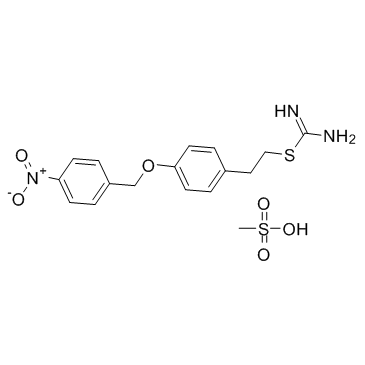182004-65-5
| Name | methanesulfonic acid,2-[4-[(4-nitrophenyl)methoxy]phenyl]ethyl carbamimidothioate |
|---|---|
| Synonyms |
HMS3267H09
KB-R7943 mesylate KB-R7943 MFCD00237019 2-{4-[(4-Nitrobenzyl)oxy]phenyl}ethyl carbamimidothioate methanesulfonate (1:1) Carbamimidothioic Acid 4-[(4-Nitrobenzyl)oxy]phenethyl Ester Methanesulfonate 4-[(4-Nitrobenzyl)oxy]phenethyl Carbamimidothioate Methanesulfonate Carbamimidothioic acid, 2-[4-[(4-nitrophenyl)methoxy]phenyl]ethyl ester, methanesulfonate (1:1) KB-R7943 (mesylate) |
| Description | KB-R7943 mesylate is a widely used inhibitor of the reverse Na+/Ca2+ exchanger (NCXrev) with IC50 of 5.7±2.1 µM. |
|---|---|
| Related Catalog | |
| Target |
IC50: 5.7±2.1 µM (Na+/Ca2+ exchanger)[1] |
| In Vitro | KB-R7943 mesylate blocks NMDAR-mediated ion currents, and inhibits NMDA-induced increase in cytosolic Ca2+ with IC50=13.4±3.6 µM but accelerates calcium deregulation and mitochondrial depolarization in glutamate-treated neurons. KB-R7943 depolarizes mitochondria in a Ca2+-independent manner. KB-R7943 inhibits 2,4-dinitrophenol-stimulated respiration of cultured neurons with IC50=11.4±2.4 µM. In addition to NCXrev, KB-R7943 dose-dependently and reversibly blocked ion currents elicited by NMDA. KB-R7943 dose-dependently inhibits NMDA-induced increases in [Ca2+]c with IC50=13.4±3.6 µM confirming the inhibition of NMDA receptors observed in electrophysiological experiments[1]. wtRyR1-HEK 293 pretreated with KB-R7943 (10 μM, 10 min) dissolved in the bulk perfusion exhibited significantly attenuated responses to caffeine. In this regard, KB-R7943 produced more pronounced inhibition of caffeine-induced Ca2+ release elicited by 1 mM compared with 0.5 and 0.75 mM (60 versus 58 versus 37%, p<0.05, respectively)[2]. KB-R7943 inhibits both IhERG and native IKr rapidly on membrane depolarization with IC50 values of ~89 and ~120 nM, respectively, for current tails at −40 mV following depolarizing voltage commands to +20 mV. IhERG inhibition by KB-R7943 exhibits both time- and voltage-dependence but shows no preference for inactivated over activated channels[3]. |
| Cell Assay | EK 293 cells stably expressing the wtRyR1 (wtRyR1-HEK 293) are maintained in Dulbecco's modified Eagle's medium supplemented with 2 mM glutamine, 100 μg/mL streptomycin, 100 U/mL penicillin, 1 mM sodium pyruvate, and 10% fetal bovine serum at 37°C under 5% CO2. wtRyR1-HEK 293 cells are loaded with 5 μM Fluo-4 acetoxymethyl ester at 37°C for 30 min to measure Ca2+ transients in an imaging buffer consisting of 140 mM NaCl, 5 mM KCl, 2 mM MgCl2, 2 mM CaCl2, 10 mM HEPES, and 10 mM glucose, pH 7.4, supplemented with 0.05% bovine serum albumin. The cells are washed three times with imaging buffer and additionally incubated for 20 min at room temperature. Dye-loaded cells are washed three times with imaging buffer and imaged with a charge-coupled device camera with a 40× objective lens attached to an IX-71 microscope. The sequence of images is captured and monitored using EasyRatioPro. Caffeine dissolved in the imaging buffer is focally applied for 15 s using AutoMate Scientific. KB-R7943 is dissolved in the imaging buffer, and wtRyR1-HEK 293 cells are incubated for 10 min before the application of caffeine[2]. |
| References |
| Boiling Point | 534.6ºC at 760mmHg |
|---|---|
| Molecular Formula | C17H21N3O6S2 |
| Molecular Weight | 427.495 |
| Flash Point | 277.1ºC |
| Exact Mass | 427.087189 |
| PSA | 192.97000 |
| LogP | 5.25100 |
| Vapour Pressure | 1.67E-11mmHg at 25°C |
| Storage condition | 2-8°C |
